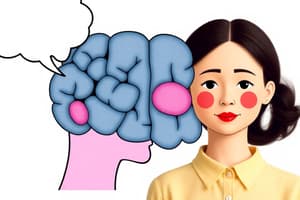Podcast
Questions and Answers
Define attitudes.
Define attitudes.
Attitudes are evaluations of people, objects, or ideas.
What are the three components of attitudes?
What are the three components of attitudes?
The three components of attitudes are affective (emotional responses toward attitude object), cognitive (thoughts and beliefs about attitude object), and behavioural (actions or observable behaviour toward the attitude object).
What are explicit attitudes?
What are explicit attitudes?
Explicit attitudes are attitudes that we can consciously endorse and can easily report.
What are implicit attitudes?
What are implicit attitudes?
How can attitudes be formed?
How can attitudes be formed?
What may explicit attitudes be formed based on?
What may explicit attitudes be formed based on?
What may implicit attitudes be formed based on?
What may implicit attitudes be formed based on?
What is the topic of Attitudes Topic 6?
What is the topic of Attitudes Topic 6?
Do attitudes predict behaviour?
Do attitudes predict behaviour?
What is cognitive dissonance?
What is cognitive dissonance?
What are the best predictors of planned, deliberate behaviors according to the Theory of Planned Behavior?
What are the best predictors of planned, deliberate behaviors according to the Theory of Planned Behavior?
What is the Elaboration Likelihood Model?
What is the Elaboration Likelihood Model?
What is the central route in the Elaboration Likelihood Model?
What is the central route in the Elaboration Likelihood Model?
What is the peripheral route in the Elaboration Likelihood Model?
What is the peripheral route in the Elaboration Likelihood Model?
According to the Yale Attitude Change Approach, what are the factors that influence attitude change?
According to the Yale Attitude Change Approach, what are the factors that influence attitude change?
What is fear-arousing communication?
What is fear-arousing communication?
What is the primary focus of the Yale Attitude Change Approach?
What is the primary focus of the Yale Attitude Change Approach?
What is the Theory of Planned Behavior?
What is the Theory of Planned Behavior?
What is the predictive power of attitudes according to Wicker (1969)?
What is the predictive power of attitudes according to Wicker (1969)?
What is the purpose of persuasive communication?
What is the purpose of persuasive communication?
What is cognitive dissonance?
What is cognitive dissonance?
What is attitude inoculation?
What is attitude inoculation?
What is the purpose of product placement in advertising?
What is the purpose of product placement in advertising?
How can cognitive defense reduce the effects of advertising?
How can cognitive defense reduce the effects of advertising?
What is post-decision dissonance?
What is post-decision dissonance?
What is the effect of dissonance on immoral behavior?
What is the effect of dissonance on immoral behavior?
What is the justification of effort?
What is the justification of effort?
What is the optimal level of fear in advertising?
What is the optimal level of fear in advertising?
What is the purpose of subliminal messages in advertising?
What is the purpose of subliminal messages in advertising?
How can individuals resist persuasive messages?
How can individuals resist persuasive messages?
Flashcards are hidden until you start studying




